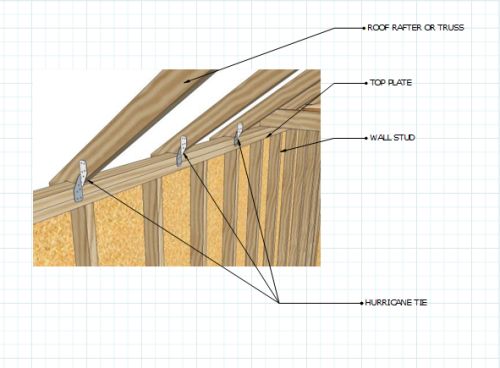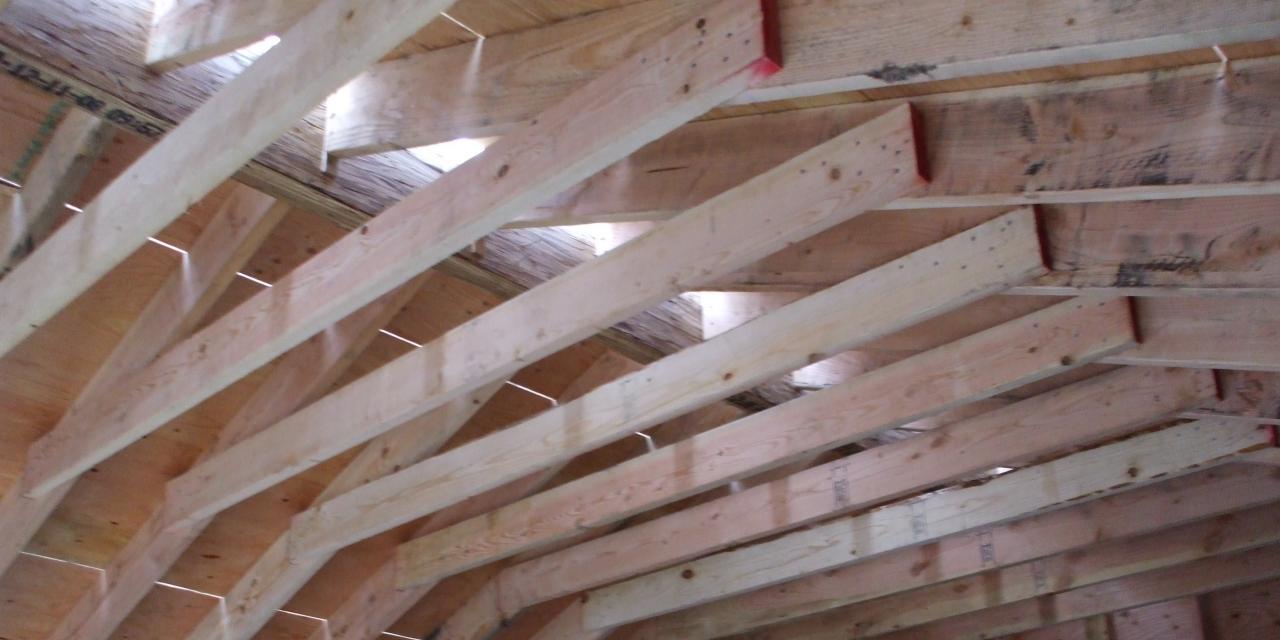

Compare this with a similarly framed 12/12 roof that has similar loads: The tie force at the plate is 480 pounds - and only 720 pounds when the ties are 4 feet up from the plate (again, the maximum allowed by code).

Moving the rafter ties up only 16 inches from the plate (the maximum allowed by code) increases the tie force from 1,440 pounds to 2,160 pounds. In this example, when W = 960, the tie-force tension at the plate when there are rafters 24 inches on-center with a 4/12 pitch and a 12-foot span is 1,440 pounds. Here’s a formula I use to determine tie force: T = W/2 x H/h x run/rise, where W equals rafter load, H equals height of ridge, and h equals distance from ridge to center of tie (illustration, below). And when rafter ties are used above the plate, the rafter span must be reduced by as much as 33 percent compared with the span allowed when the ties are at the plate. If your garage is 24 feet wide and has a 4/12 roof, the new rafter ties can be placed no more than 16 inches up from the plate without additional engineering.įrom a practical perspective, it’s difficult to use high rafter ties on a low-pitched roof because the force in each tie increases with the inverse of the pitch. Previous building codes permitted rafter ties to be placed as high above the plate as two-thirds the distance between the top plate and the ridge, but the 2006 IRC now limits this height to one-third the distance between the plate and the ridge (see Footnote A, Table R802.5.1, 2006 IRC). To resist thrust, the IRC calls for a structural ridge (required for any roof with a pitch less than 3/12) or for each pair of rafters to be securely connected to each other by a continuous ceiling joist (R802.3, 2006 IRC).Ĭode does allow joists to be installed above the top plate, but only under certain conditions. This horizontal load - or thrust - can be considerable, especially on a low-pitched roof.

Jordan Truesdell, a structural engineer in Blacksburg, Va., responds: In a simple gable roof, the rafters carry live and dead loads that push both down and out against the top of the supporting walls. As a compromise, can I replace the existing ceiling joists with rafter ties?Ī. They like the idea of a vaulted ceiling but not the expense of the new structural ridge it would require. My clients have a garage with a conventionally framed 4/12 roof that they want to convert to living space. I'm not going to attempt to replace these joists myself but before I start asking builders to take a look I would like to know what to expect when I ask them how they intend to replace them so I can better judge which of them knows their stuff.Q. I'm afraid I don't have exact measurements or a photo to hand but hopefully you get the idea. There is also a large timber (from memory, about 180x180mm in profile) running perpendicular to the ceiling joists, in the middle of the span, on top of them, and bolted down in places. Including the thickness of the walls I would say the joists are around the 6-7m mark. The internal span is about 4-5m and the external overhang is about 400mm on one side and 800mm on the other. The roof construction is a simple A-frame with collar ties sitting on brick walls. Most of the timbers look fine apart from two ceiling joists which have gone soft. One of the first and most important jobs I'll have to do is the roof.


 0 kommentar(er)
0 kommentar(er)
